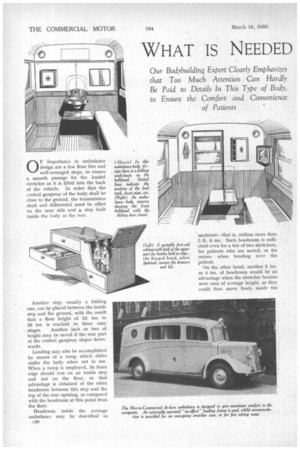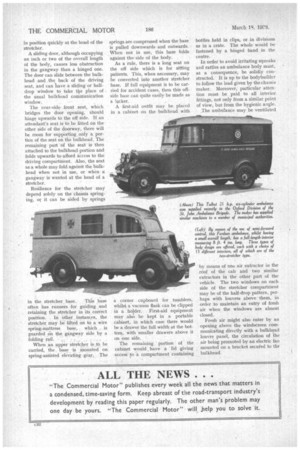WHAT IS NEEDED
Page 76

Page 77

Page 78

If you've noticed an error in this article please click here to report it so we can fix it.
IN AMBULANCE BODYWORK Our Bodybuilding Expert Clearly Emphasizes that Too Much Attention Can Hardly Be Paid to Details In This Type of Body, to Ensure the Comfort and Convenience
of Patients
0 F importance in ambulance design are a low floor line and well-arranged steps, to ensure a smooth passage for the loaded stretcher as it is lifted into the back of the vehicle. In order that the central gangway of the body shall be close to the ground, the transmission shaft and differential must be offset on the near side and a step built inside the body at the rear.
Another step, usually a folding one, can 14e placed between the inside step and the ground, with the result that a floor height of 24 ins. to 26 ins, is reached inthree easy stages. Another inch or two of height may be saved if the rear part of the central gangway slopes downwards.
Loading may also be accomplished by means of a ramp which slides under the body when not in use. When a ramp is employed, its front edge should rest on an inside step and not on the floor, so that advantage is obtained of the extra headroom between this step and the top of the rear opening, as compared with the headroom at this point from the floor.
Headroom inside• the average ambulance may be described as C30 moderate—that is, seldom more than 5 ft. 0 ins. Such headroom is sufficient even for a tier of two stretchers, for patients who are seated, or for nurses when bending over the patient.
On the other hand, another 3 ins. or 4 ins, of headroom would be an advantage when the stretcher bearers were men of average height, as they could then move freely inside the ambulance. Headroom should not be curtailed by the projection of any lamps or other fittings over the central gangway.
Height is usually restricted in order to save weight and to imptove the general appearance of the ambulance. The apparent height of the vehicle is reduced by a well domed roof, which is carried forward over the cab. At this point space is available above the driver for a tank which supplies a folding wash-basin mounted behind the bulkhead.
The stretcher compartment is, nowadays, a few inches longer, than formerly. Apart from the fact that extra length reduces the apparent height, it also means more comfort, especially for a tall occupant of the stretcher.
Also, there is space available if necessary between the head of the stretcher and the bulkhead. Thus, there is plenty of room for attending to the head of the patient and free access to the stretcher when lowering or raising it.
When the stretcher compartment has an inside length of 8 ft. to 8 ft. 6 ins., there will be 10 ins. or 12 ins. of space between the front stretcher handles and the bulkhead. This space may be left free, or fitted with a folding stretcher extension, or it may even be large enough to seat an attendant or patient.
Verbal communication between the stretcher and driver's compartments is often required, for which reason there may be a sliding panel or window on the off side of the bulkhead. A door in the front bulkhead also saves time when loading or unloading, because any stretcher bearer travelling in the cab would be in position quickly at the head of the stretcher.
A sliding door, although occupying . an inch or two of the overall length of the body, causes less obstruction in the gangwaythan a hinged one. The door can slide between the bulkhead and the back of the driving seat, and can have a sliding or halfdrop window to take the place of the usual bulkhead communication window.
The near-side front seat, which bridges the door opening, should hinge upwards to the off side. If an attendant's seat is to be fitted on the other side of the doorway, there will be room for supporting only a portion of the seat on the bulkhead. The remaining part of the seat is then attached to the bulkhead portion and folds upwards to-afford access to the driving compartment. Also, the seat as a whole may -fold against the bulkhead when not in use, or when a gangway is wanted at the head of a stretcher.
Resilience for the stretcher may depend solely on the chassis springing, or it can be aided by springs in the stretcher . base. This _base often has runners for guiding and retaining the stretcher in its correct
position. In other instances, the stretcher may be lifted on to a wire spring-mattress base, which is guarded On the gangway side. by a folding rail. , _ . . When an upper stretcher is .to be carried, the base _-is _mounted on spring-assisted elevating gear. The
springs are compressed when the base is pulled downwards and outwards. When not in use, this base folds against the side of the body.
As a rule, there is a long seat on the off side which is for sitting patients. This, when necessary, may be converted into another stretcher base. If full equipment is to be carried for accident cases, then this offside base can quite easily be made as a locker.
A first-aid outfit may be placed in a cabinet on the bulkhead with a corner cupboard for tumblers, whilst a vacuum flask can be clipped in a holder. First-aid equipment may also be kept in a portable cabinet, in which case there would be a drawer the full width at the bottom, with smaller drawers above it on -one side.
The remaining portion of the cabinet would have a lid giving access to a compartment containing bottles held in clips, or in divisions as in a crate. The whole would be fastened by a hinged band in the centre.
In order to avoid irritating squeaks and rattles an ambulance body must. as a consequence, be solidly constructed. It is up to the bodybuilder to follow the lead given by the chassis maker. Moreover, particular attention must be paid to all interior fittings, not only from a similar point of view, but from the hygienic angle.
The ambulance may be ventilated by means of one air extractor in the roof of the cab and two similar extractors in the other part of the vehicle. The two windows on each side of the stretcher compartment may be of the half-drop pattern, perhaps with louvres above them, in order to maintain an entry of fresh air when the windows are almost closed.
Fresh air might also enter by an opening above the windscreen communicating directly with a bulkhead louvre panel, the circulation of the air being promoted by an electric fan mounted on a bracket secured to the bulkhead.












































































































































